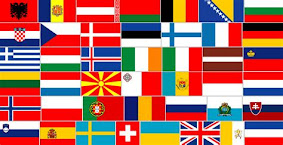Soccer -- fútbol, Fußball, futebol, football-- is the world’s most popular sport, and literally hundreds of millions of people are now watching the 2010 World Cup. The championship has also attracted the interest of many non-sports fans since it’s being held in South Africa and marks the first ever World Cup held on the African continent.
The media coverage of the event --
at least the American coverage on ABC and ESPN --monotonously details the
alleged evils of apartheid and the glories of the Soweto riots.
Various segments between matches portray Nelson Mandela as little short of a
god and faithfully follow Hollywood’s White Devils/Black Angels script.
Needless to say, there is no discussion of ANC terrorism or the murders of
over 4,000white farmers since the end of apartheid.
Race is also on display on the pitch
and for all the talk of diversity, multiculturalism, and a global community,
most of the 32 teams in the field feature racially exclusive teams.
European and South American teams
dominate world soccer and have won every single World Cup. But to make the
event a truly global affair, there are quotas for each region so that everyone
feels represented.
I watched each opening round game
and noted the races of all 11 starters for each squad. All five sub-Saharan
Africa squads (Nigeria, South Africa, Ivory Coast, Ghana and Cameroon) start
all blacks. All three Asian teams (Japan, South Korea and North Korea) start
all Asians. The one North African team (Algeria) starts all Arabs. The eastern
European teams (Slovenia, Slovakia, and Serbia) start all whites.
Australia and New Zealand are not
soccer powers but each qualified this year. Australia starts an all white team
and New Zealand starts 10 whites and one aboriginal (probably a Maori).
Latin American teams are a mixed bag
racially, much like the region itself. The races of some of the players are
often hard to pinpoint. Are they mestizos or darker skinned whites of
Portuguese or Spanish descent?
The three white nations of Latin
America start mostly white sides. Argentina starts nine or 10 whites with one
or maybe two mestizos. Uruguay starts nine whites with one clear mestizo and
one clear Negro. Chile starts seven or eight whites with three or four
mestizos.
Mexico and Paraguay have a starting
11 consisting of a mixture of whites and mestizos. Honduras starts eight
mestizos and, surprising, three blacks.
Brazil starts four whites and seven
players who are black or racially mixed.
The United States again made the
tournament and has a decent shot of advancing to the next round of 16. Racially,
the team starts seven whites and four blacks. Mestizos are now about 15 percent
of the U.S. population, but there are only three Hispanics on the team and one
of them -- Carlos Bocanegra -- is clearly a white Hispanic. The two mestizos
are backups and there are no Asians or Middle Easterners on the U.S. squad. The
U.S. is being overwhelmed with millions of soccer-mad immigrants every year.
Why aren’t these people making the national team?
So far, most nations of the world
have teams that racially represent their people. Black Africans, Asians, Arabs,
and Eastern Europeans (God bless ‘em) can support teams that reflect them 100
percent. Whites in Australia and New Zealand can still proudly support a team
that looks like them.
Blacks are overrepresented on the
Brazilian side, but most Latin American nations have squads that reflect their
racial demographics. Americans are no doubt used to blacks being
overrepresented on national sports teams, but the current squad has enough
whites so that it is not viewed as alien -- like the often all-black U.S. national basketball team.
We are constantly told that
multiculturalism and diversity are unalloyed blessings. But of course, white
nations are the only countries that are enjoying these blessings -- and it is
starting to show in the national squads of the Western European teams.
Italy has won four World Cups
including the last one in 2006. They cling stubbornly to the view that Italians
don’t need blacks to win World Cups and still start an all-white (and, with one
exception, all-Italian) side.
This year’s team is pretty old and may not be a threat to win it all. But it
will no doubt go far into the tournament.
Germany has won three World Cups and
is always a threat to win it all. This year’s starting squad can be described
-- depending on your definition of white -- as either all-white or as nine
whites and two Turks. Like Italy, the Germans have stubbornly resisted starting
supposedly superior black players.
France has shown no such
resistance. Historically not a soccer power,
they won their only World Cup in 1998 with four black starters and apparently
attributed the victory to having more blacks. They have consistently fielded
seven blacks starters since and this year is no exception as the four true
Frenchmen who start for France stand out on the pitch. The French side
represents Africa and not the traditional French nation. Happily, the side is
beset with squabbling and will probably go home early this year.
England won
their only World Cup in 1966 with an all-white side but is perhaps going the
way of France. They started a bare majority of whites over blacks in their
first round game. They may start 7 whites for the next game but the team is
trending black. Perhaps if England is bounced from the tournament in the first
round it will change things. The team disappointed in a first round draw versus
the U.S.
Spain is
the favorite to win the whole thing. Like the Italians, the Spanish are all
white and have found great success lately. The winners of the 2008 European Cup
are loaded with talent but inexplicably lost to Switzerland in the first round.
If they can regroup and win their first World Cup it will be another major
argument against the Africanization of European soccer.
Portugal also
has an outside chance to win the whole tournament. Led by the great Cristiano
Ronaldo, the squad starts 10 whites and one black.
The Greeks round out a solid
Southern European contingent with an all-white side.
A few years ago, the Netherlands
seemed on the verge of becoming another France. This year’s squad starts nine
whites but has several black substitutes who will see playing time. Like
Portugal, they have an outside shot at winning the World Cup.
Denmark has 10 whites and one black
who distinguished himself by accidentally hitting the ball into his own net and
losing the first game for the Danes.
Switzerland starts two blacks and an
Arab. But the team still retains an overall European identity and pulled a huge
upset over Spain in the first round of games.
By looking at the 32 squads we can
learn some lessons in terms of race, immigration, and demographics. Because of
immigration, the complexion of Western Europe is changing, and it is showing up
in the composition of soccer teams that used to be all-white up even into the
1990s.
Since only white nations let in
millions of people of different races, they are the only countries to be
effected by demographic change. Asians, Africans (both Arab and black) and
mestizos can be sure their national soccer teams will always represent them. If
Eastern Europe can hold the line on immigration, they can also be confident
that their teams will always reflect them as well.
Australia, New Zealand and the U.S.
are also being heavily hit by Third World immigration, though it has yet to
have a major impact on the complexion of their squads. But for how long?
Another lesson is that it is mainly
blacks who are changing the face of the Western European soccer teams. There
are many more Arabs and Middle Easterners in France and the Netherlands than
blacks. Why are these significant minorities absent from the starting lineups?
In England, there are many more Pakistanis, Indians, and Bangladeshis than
blacks. Yet they are not represented on the national team. As noted, mestizos
and Asians have yet to make an impact on the U.S. side.
A proper HBD response might be that
blacks are better athletes than whites, and much better athletes than Arabs,
Asians, and mestizos. But that is certainly not reflected in the World Cup
results. All-black African sides are losers who have never come close to
contending for the World Cup, though soccer is universally played throughout
the Dark Continent. Some might say they need better training and coaching, but
all black African teams are currently coached by whites. Even the Asian sides
usually outplay the all-black nations. Though they enjoy home field advantage,
the record of the all-black teams at this writing is a pathetic one win, four
losses, and two draws. It is possible that none will advance to the next round
of 16.
On a more political note, I noted
the typically fawning news coverage the media have given South Africa. They
have not been too curious about the robberies of players and fans and the
killings (one victim was Nelson Mandela’s great granddaughter, which kept him
from the opening ceremonies) that have occurred around the event.
Several commentators have referred
to the “the rainbow nation” of South Africa without wondering why the national
team is all black. This is especially ironic as the ANC has
mandated quotas for the sport of rugby to ensure some black representation in
this white-dominated sport.
On a positive note, it looks as
though this year’s champion will be a nation with an all-white or almost
all-white side. Argentina and Germany looked particularly good in the first
round of play and Spain, Portugal, Holland and the Italians cannot be counted
out. Only Brazil, with a racially mixed squad, will threaten white dominance of
the World Cup this year.
Let’s enjoy it while it lasts.
































No comments:
Post a Comment
Your comment will appear after it has been checked for spam, trolling, and hate speech.